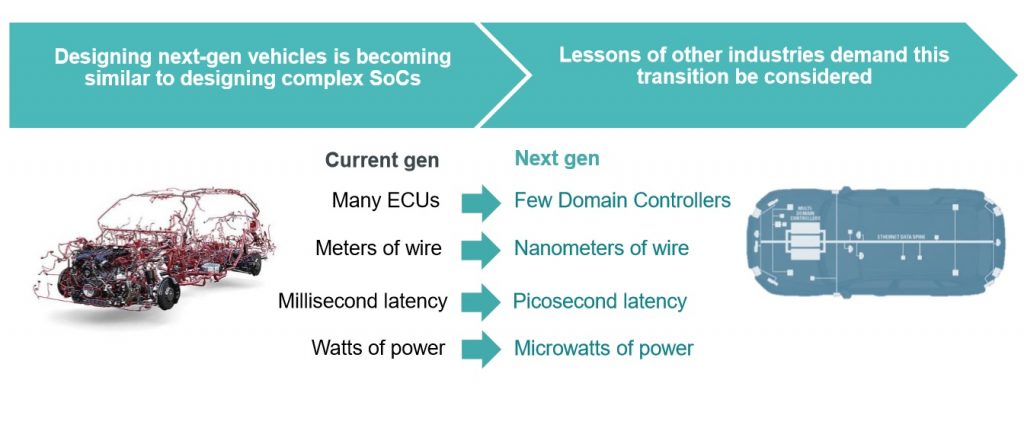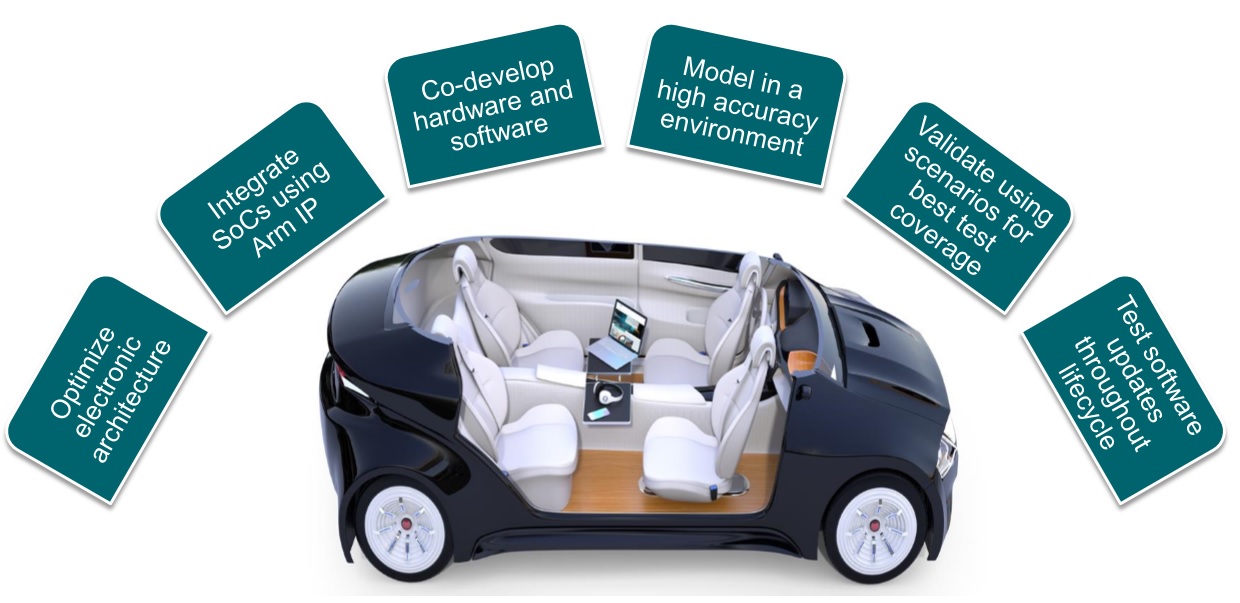By Junko Yoshida
LAS VEGAS — Bolstered by its new partnership with Arm, Siemens is ready to ask car OEMs some tough questions at the Consumer Electronics Show. Namely: 1) Do you already know what the architecture of your 2025 automotive platform looks like? 2) If so, have you verified your whole vehicle?
In an interview with EE Times, David Fritz, global technology manager, Autonomous and ADAS at Siemens, explained that if carmakers are still dithering with issues like which CPU, GPU, or MPU they should use in next-generation cars, “they’ve already missed the boat.”
Fritz described recent automotive history as making “a series of incremental changes to advanced driver-assistance systems (ADAS).” While carmakers might feel compelled to add hot new features that pop up in the market, too many have resorted to “one Band-Aid solution after another” for new models, he said, arguing that they’ve been doing so without really thinking about the architecture of 2025 vehicles. That’s one reason, he said, why car OEMs have failed to chart a single migration path from ADAS to autonomous vehicles (AVs).
Recommended
Car OEMs See No Easy ADAS-to-AV Path
Envision your vehicle platform of 2025
Siemens’s new partnership with Arm seeks to alter the ad hoc — and often siloed — design choices that automakers have been making for vehicle development.

The partnership will combine pre-built and pre-verified Arm IPs with Siemens’s PAVE360 — billed as an all-encompassing validation and simulation system designed for autonomous vehicle hardware and software development. The goal is to enable automakers and suppliers to “envision their next-generation automotive platform,” said Fritz.
He explained that Siemens’s PAVE360 extends “digital twin simulation beyond processors to include automotive hardware and software subsystems, full vehicle models, fusion of sensor data, traffic flows, and even the safety of autonomous vehicles.”
If a carmaker chooses a certain processor for specific applications in, say, a 2020 vehicle, what could happen is that the new chip might not fit the enclosure size required in a 2025 car platform. Similarly, it might not meet the heat dissipation threshold demanded in the 2025 architecture. “You make one decision now, which turns out to make a bang-bang-bang domino effect in the rest of the whole 2025 car model,” said Fritz.
Put more bluntly, Fritz said that a carmaker’s bad decision six years ago could end up killing the entire new model for 2025.
It’s important for carmakers and Tier Ones to be able to “simulate and verify subsystem and system-on-chip designs and to understand how they perform within a vehicle design from the silicon level up, long before the vehicle is built,” he explained.
Siemens’s Fritz last year told EE Times, “I have actually seen a block diagram of an AV SoC internally designed by every major car OEM.” He stressed, “Tesla isn’t alone. Every carmaker wants to control its own destiny.” If so, with how many of those major car OEMs is Siemens already working today — to simulate and verify their whole car architecture of 2025?
Fritz said, “We’ve been working with a few,” without naming names. When asked to describe a 2025 vehicle architecture, he said, “While they all come from different directions, surprisingly, they appear to come to a similar platform.”
Why PAVE360?
The power of PAVE360 lies in its ability to simulate certain functions, SoCs, subsystems, or software in the context of an entire vehicle. Phil Magney, founder and principal advisor of VSI Labs, last year told EE Times that PAVE360 is “pretty unique.” He explained that the foundation of Siemens’s PAVE360 is a concept called the “digital twin.” Noting that a digital twin is a duplicate (simulated) version of the real world, Magney said, “For developers of vehicles or components, this literally means they can fully simulate their targets at any scale, whether it is a chip, software competent, ECU, or complete vehicle.”
In short, as Fritz claimed, the advantage of PAVE360’s methodology is its ability to correlate simulation with the physical platform.
Fritz pointed out a huge difference between simulating an SoC on a PC, for example, and simulating it in the context of a whole vehicle. “The two [approaches and their results] are so far away.”
What’s in it for Arm?
The advantage for Siemens working with Arm is clear. Given the ubiquity of Arm cores in a host of automotive chips, Siemens’s deepened relationship with Arm only adds fuel to PAVE360’s broader appeal.
But what’s in it for Arm?
First, associating Arm core designs with PAVE360 enhances the credibility of Arm as a provider of IP cores for the automotive market.
Mark Fitzgerald, associate director, Automotive Practice at Strategy Analytics, added, “Arm gains the ability for easier, faster design of custom chips for ADAS and autonomous applications.” He said that “automakers are moving to custom silicon (i.e., Tesla’s Full Self-Driving chips) rather than relying on off-the-shelf solutions, with some OEMs working on in-house solutions.” He noted, “The teaming up allows chip designers to use Arm architecture and IP along with Siemens’s PAVE360 to create custom ADAS and autonomous driving SoCs in a virtual environment.”

Asked about how long Siemens has been working with Arm, Siemens’s Fritz told us “almost a year.” But the relationship between the two companies got a lot closer, as they have been engaged in more detailed, weekly engineering calls since last summer, when the legal arrangement between Siemens and Arm got sorted out. Under the agreement, Siemens today has access to all of Arm’s wide-ranging IP cores. Siemens is now in a position to discuss with Arm specific processing core designs such as Arm’s split lock logic or big.LITTLE architecture when placed against certain applications in the real world.
So what sort of changes might the industry expect from Arm in its future cores or processor architecture for the automotive market?
Strategy Analytics’ Fitzgerald told EE Times, “The likely trend would be to produce a single, very powerful chip for an ADAS or autonomous driving domain controller rather than distributed computing that is used today. OEMs will choose the best mix of centralized versus distributed computing based on application.”
What about other processor IP guys?
To be clear, Arm isn’t the only processor core IP supplier. Mobileye, now an Intel company, has been using MIPS cores for years. Ceva and Imagination might be also seeking to get designed into chips for digital cockpits or automotive perception chips, for example.
Asked if Siemens is planning to work with other IP suppliers, Fritz said, “The beauty of our system is that they can plug their cores in the cloud” tied to PAVE360 in order to evaluate their cores in the context of a whole vehicle.
Fitzgerald noted, “The biggest risk in missing out on the collaboration that PAVE360 offers is between OEMs, semi vendors, software providers, and Tier One suppliers.”
He said, “Chip vendors can gain by working with Arm IP and PAVE360 tools to quickly validate and verify chip design more efficiently and cost-effectively.” However, he cautioned, “Chip vendors can also be threatened if an OEM or even a large-tier supplier decides to use Arm IP and the PAVE360 tools to design chip solutions — taking the chip vendors out of the design/validation loop.”
Competitors to Siemens
Other vendors are also offering similar verification tools, according to Fitzgerald.
Cadence, for example, provides design tools across all the PCB, system-in-package (SiP), and SoC fabrics, which makes it possible to do coherent and integrated ECU design and analysis.
ANSYS, on the other hand, enables customers to do “multi-physics simulations to simultaneously solve power, thermal, variability, timing, electromagnetics, and reliability challenges across the spectrum of chip, package, and system to promote first-time silicon and system success.”
Last fall, Synopsys launched native automotive solutions “optimized for efficient design of autonomous driving and ADAS SoCs.”
Vector, meanwhile, claims to offer “comprehensive solutions” for developing ADAS systems in the form of software and hardware tools and embedded components. These include measuring instruments to acquire sensor data, checking and optimizing ECU functions, software components, and algorithm design.
Siemens’s Fritz, however, made it clear that, overall, nobody does the job as comprehensively as PAVE360.



